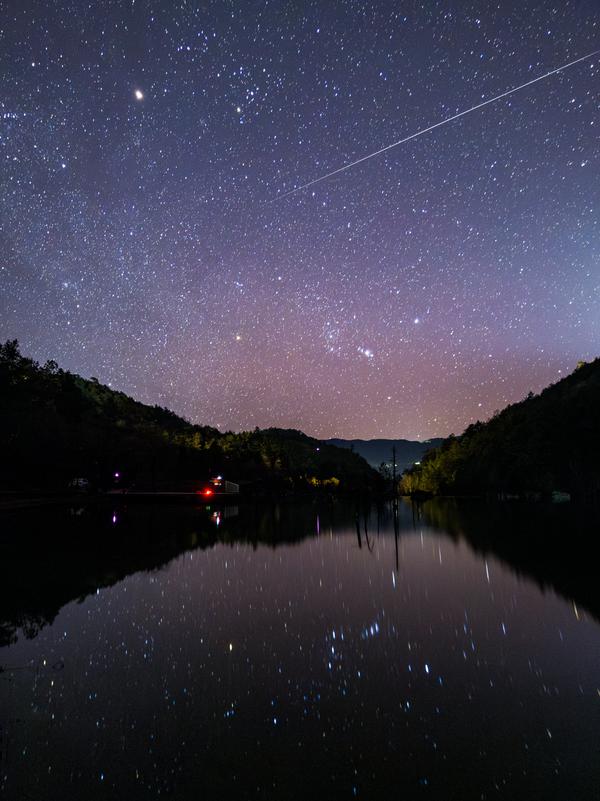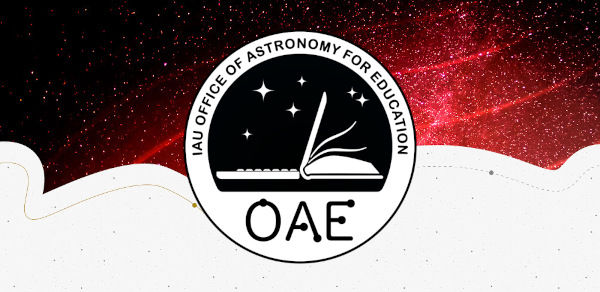This page describes an image The Geminid Fireball
Image caption:
Captured with a smartphone on 13 December 2022, a Geminid meteor illuminated the sky above Blue Moon Valley in Yunnan, China, casting a breathtaking display against the serene backdrop of the Jade Dragon Snow Mountain. Renowned for their dazzling brightness and vivid hues, the Geminids are among the most vibrant meteor showers, originating from the asteroid 3200 Phaethon. Each year, as our planet traverses Phaethon’s debris trail, fragments of dust and rock vaporise in the atmosphere, creating the stunning phenomenon of the Geminid meteor shower. In this stunning night sky image, the twin stars of Gemini (Castor and Pollux) are obscured by the silhouetted trees on the left. Mirrored in the calm waters are the stars that make up the constellation of Orion, which can be seen rising towards the bottom-centre of the image, while the radiant Mars retains its brilliance as the foremost celestial beacon in the scene, all before the moonrise takes over.
Scroll to captions in other languages
Image credit:
Jianfeng Dai/IAU OAE (CC BY 4.0)
DOI: 10.5281/zenodo.10359628
Tags:
astrophotography
Related glossary terms:
Gemini
, Shooting Star
Categories:
Naked Eye Astronomy
, Solar System
Image license: Creative Commons Attribution 4.0 International (CC BY 4.0) Creative Commons Attribution 4.0 International (CC BY 4.0) icons
The media file captions presented on the OAE website were written, translated and reviewed by a collective effort from the OAE, the OAE Centers and Nodes, the OAE National Astronomy Education Coordinators (NAECs) and other volunteers. You can find a full list of credits for our translation project here. All media file captions are released under a Creative Commons CC BY-4.0 license and should be credited to "IAU OAE". The media files themselves may have different licenses (see above) and should be credited as listed above under "credit".
Captions in Different Languages:
Image caption: Photographié avec un smartphone le 13 décembre 2022, un météore des Géminides a illuminé le ciel au-dessus de la Vallée de la Lune Bleue, Yunnan, en Chine, offrant un spectacle à couper le souffle sur fond de sérénité de la Montagne des Neiges du Dragon de Jade. Réputées pour leur luminosité éblouissante et leurs teintes vives, les Géminides font partie des pluies de météores les plus vibrantes provenant de l'astéroïde 3200 Phaethon. Chaque année, lorsque notre planète traverse la traînée de débris de Phaethon, des fragments de poussière et de roche se vaporisent dans l'atmosphère, créant le phénomène stupéfiant de la pluie de météores des Géminides. Sur cette superbe image du ciel nocturne, les étoiles jumelles des Gémeaux (Castor et Pollux) sont masquées par la silhouette des arbres à gauche. Dans les eaux calmes se reflètent les étoiles de la constellation d'Orion, que l'on voit s'élever vers le centre inférieur de l'image, tandis que Mars, radieuse, conserve son éclat en tant que premier phare céleste de la scène, avant que le lever de la lune ne prenne le relais.
Image credit: Jianfeng Dai/IAU OAE (CC BY 4.0)
Related glossary terms: Gémeaux , Étoile filante Caption translation status: Not yet approved by a reviewer
Caption translators: Rulx Narcisse
Image caption: Menzione d'onore al concorso di astrofotografia IAU OAE 2023, categoria Immagini fisse con smartphone-dispositivi mobili: The Geminid Fireball, di Jianfeng Dai.
Il 13 dicembre 2022, una meteora Geminide ha illuminato il cielo sopra la Blue Moon Valley nello Yunnan, in Cina, regalando uno spettacolo mozzafiato sullo sfondo sereno della Jade Dragon Snow Mountain. Questa immagine che ha catturato il momento riceve una menzione d'onore nella categoria Immagini fisse scattate esclusivamente con smartphone/dispositivi mobili. Rinomate per la loro luminosità abbagliante e le tonalità vivaci, le Geminidi, originate dall'asteroide 3200 Phaethon, sono tra le piogge di meteoriti più vivaci. Ogni anno, quando il nostro pianeta attraversa la scia di detriti di Phaeton, frammenti di polvere e roccia si vaporizzano nell'atmosfera, dando vita allo straordinario fenomeno dello sciame meteorico delle Geminidi. In questa splendida immagine del cielo notturno, le stelle più brillanti dei Gemelli (Castore e Polluce) sono oscurate dalle sagome degli alberi sulla sinistra. Nelle acque calme si specchiano le stelle che compongono la costellazione di Orione, che si vede sorgere verso il centro in basso dell'immagine, mentre il radioso Marte mantiene la sua brillantezza come primo faro celeste della scena, il tutto prima che il sorgere della luna prenda il sopravvento.
Image credit: Jianfeng Dai/IAU OAE (CC BY 4.0)
Related glossary terms: Gemelli , Stella cadente Caption translation status: Not yet approved by a reviewer
Caption translators: Valentina La Parola









